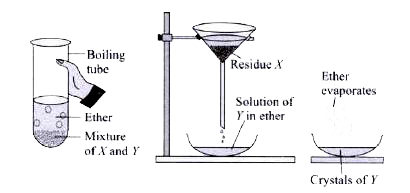The constituents of a heterogeneous mixture are X, Y and Z. If mixture containing X and Y is taken, X can be separated using magnetic separation, Y and Z can be separated using distillation method. Which of the following best identifies X, Y and Z respectively?
Iron, salt, water
Sulphur, carbon disulphide, water
Gun powder, common salt, water
lodine, sand, alcohol
The correct Answer is:A
To solve the problem, we need to identify the substances X, Y, and Z based on the separation methods mentioned: magnetic separation and distillation.
1. Understanding the Separation Methods:
- The problem states that X can be separated using magnetic separation. This implies that X has magnetic properties.
- Y and Z can be separated using distillation, which is typically used for separating components based on their boiling points.
2. Identifying X:
- Since X can be separated using magnetic separation, it is likely a magnetic material. Common examples of magnetic materials include iron, nickel, and cobalt.
- Given the context of a mixture, X is most likely iron (Fe), as it is a common magnetic substance.
3. Identifying Y and Z:
- The remaining components Y and Z can be separated by distillation. A common mixture that can be separated this way is saltwater, where:
- Y could be salt (sodium chloride, NaCl).
- Z could be water (H₂O).
- Distillation works here because when saltwater is heated, water evaporates and can be condensed back into liquid, leaving the salt behind.
4. Final Identification:
- Therefore, we can conclude:
- X = Iron (Fe)
- Y = Salt (NaCl)
- Z = Water (H₂O)
Conclusion:
The best identification of X, Y, and Z respectively is:
- X = Iron
- Y = Salt
- Z = Water
- The problem states that X can be separated using magnetic separation. This implies that X has magnetic properties.
- Y and Z can be separated using distillation, which is typically used for separating components based on their boiling points.
- Since X can be separated using magnetic separation, it is likely a magnetic material. Common examples of magnetic materials include iron, nickel, and cobalt.
- Given the context of a mixture, X is most likely iron (Fe), as it is a common magnetic substance.
- The remaining components Y and Z can be separated by distillation. A common mixture that can be separated this way is saltwater, where:
- Y could be salt (sodium chloride, NaCl).
- Z could be water (H₂O).
- Distillation works here because when saltwater is heated, water evaporates and can be condensed back into liquid, leaving the salt behind.
- Therefore, we can conclude:
- X = Iron (Fe)
- Y = Salt (NaCl)
- Z = Water (H₂O)
The best identification of X, Y, and Z respectively is:
- X = Iron
- Y = Salt
- Z = Water
Topper's Solved these Questions
Similar Questions
Knowledge Check
- Question 1 - Select One
Identify the mixture which can be separated by magnetic separated by magnetic separation method.
Achalk powder + sandBiron + sandCcommon salt + sandDsulphur + sand - Question 2 - Select One
The given diagram represents an activity to separate a mixture of two substances X and Y:

Substances X and Y are respectivelyAsugar and common saltBacetone and waterCammonium chloride and naphthaleneDethyl alcohol and sodium chloride. - Question 3 - Select One
If x+y+z=0, then (x+y)(y+z)(z+x) is equal to which of the following:
A−xyzBx2+y2+z3Cx3+y3+z3+3xyzDxyz
A mixture is made up of three components X, Y and Z. X particles are heavy, insoluble and non- magnetic. Y particles are very light and non-magnetic. Z particles are magnetic in nature. Give the methods to separate X, Y and Z.
View Solution_________ liquids can be separated from their mixtures by the method of distilation.
View SolutionA mixture contains camphor powder, iron powder and common salt. Identify the separation methods that are employed to separate the constituents from the mixture.
View SolutionA mixture containing substance 'X' and 'Y' is mixed with a substance 'Z' . If Z' reacts with both X and Y then, select the correct option (s).
View SolutionA mixture of carboxyliic acids (X) and (Y) cannot be separated by normal methods however when this mixture is treated with optically active quinine give optically acitve salts (P) and (Q). These two salts can be separated by fractional crystallization, separated and acidified with HCl to from amines and carboxylic acids.
The compound (X) and (Y) may beView Solution


